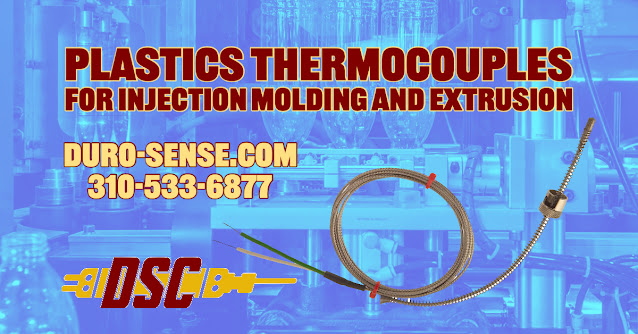A blog providing information about industrial temperature measurement, specifically in the areas of temperature sensors. The posts will contain educational information about thermocouples, RTDs, and other common types of temperature sensors. The application of these sensors will focus on aerospace, aircraft, research and development, medical, chemical, plastics processing, and power generation industries. For more, visit Duro-Sense.com or call 310-533-6877.
Monday, March 21, 2022
Thursday, February 17, 2022
Thermocouples Used in The Plastics Molding and Forming Industry
Wednesday, January 19, 2022
Engine, Turbine and Compressor Thermocouples
Wednesday, December 22, 2021
Thursday, November 11, 2021
Monday, July 26, 2021
Protecting Against Noise in Thermocouple Installations
Thermocouples are widely used to measure temperature because they are durable, affordable, and have a wide temperature range. A thermocouple is formed by the joining of two different metal alloys at a common point referred to as the measuring or hot junction. Thermocouple lead wires attach to a temperature measuring instrument at a second connection point called the reference or cold junction. When the hot junction is heated, the thermocouple generate a very modest DC voltage. The tiny voltage signal is detected by the temperature measuring instrument and converted to a temperature reading.
Thermocouples produce voltages in the millivolt range, with microvolt changes per degree C temperature change. The signal (voltage) of a standard thermocouple is low, on the order of 10 mV, and the signal-to-noise ratio can rapidly drop in the presence of the types of electrical noise seen in most industrial situations. A small amount of noise can have a significant impact on precise measurement.
There are numerous sources of noise that can interfere with thermocouple measurements. The three most typical sources of noise are as follows:
Common Mode Noise from Ground Loops
Common mode noise generates an undesirable voltage on both leads of the thermocouple. Common mode noise is typically induced by a ground loop, which occurs when a system has a potential difference between two grounds. Because the tip of a thermocouple is a bare wire junction, a ground loop might form. If the tip is grounded where it is detecting temperature and that ground is at a different potential than the ground at the thermocouple's measuring end, a ground loop forms and current flows.
Normal Mode Noise from Electromagnetic Fields
Normal mode noise generates a current that flows in the opposite direction as the measuring current. This form of noise is often created by massive alternating current current sources, such as power lines, which generate a magnetic field. The magnetic field, in turn, generates a current in the measurement path. Motors, lights, and power lines are examples of high-current devices. Normal mode noise is typically at 50/60 Hz line frequency. The normal mode error current is proportional to the field intensity, the size of the loop, and the loop's orientation to the field.
Electrostatic Noise from Rotating Equipment
Stray capacitance introduces electrostatic noise into the measuring path. Electrostatic noise is created by rotating equipment, which generates an alternating current (AC) current that is capacitively connected into the measurement route. Electrostatic noise can be coupled by stray capacitance through the tip of a thermocouple.
The following procedures will significantly reduce thermocouple susceptibility to electrical noise in an industrial setting.
- Twist and foil shield the extension or lead wires from the thermocouple to the measurement instrument. Twisting wires together minimizes both outgoing and incoming noise caused by electromagnetic interference. Each wire in the circuit carries voltages that are both equal and diametrically opposed. The voltages on the two lines are the same, but the polarity is reversed. The polarity of the magnetic field formed around the wire is determined by the polarity of the electric voltage going through the wire. Not only is the polarity of the electric voltage on each wire opposite, but so is the polarity of the magnetic fields radiating from each wire. When equal but opposing forces collide, they cancel each other out.
- Ground the measurement junction at the point of measurement. The grounding is typically to the inside of the stainless steel sheath that covers the actual thermocouple. The advantage of grounding the measurement junction is that the electrical noise is distributed equally on each wire of the thermocouple.
- Use a transmitter with excellent common mode voltage rejection and position it as close to the thermocouple as possible.
Thursday, June 24, 2021
Critical Electricity Generation on Offshore Oil Platforms Rely on Robust Engine-Compressor Thermocouple Design
Powering a wide range of complex equipment on offshore oil and gas installations necessitates a considerable amount of continuous electricity. Pumps, valve operators, critical communications, turntables, engines, and safety devices are just a few examples of the drilling and processing environment that require a dependable power source. A vast amount of electrical power, comparable to that of a small town, is needed. Heaters, air conditioners, water desalination, food storage, and even trash processing need electricity from electric generators.
The circumstances on offshore sites are challenging. Equipment and components must be sturdy to perform correctly and reduce the need for routine maintenance.
Temperature is one of the most crucial measuring factors for a compressor, and its precision directly impacts compressor efficiency. According to the findings, temperature calculation errors account for more than 80% of efficiency errors. More aspects of compressor temperature measurement, as well as improved temperature measurement methods, are required. Thermocouples measure the temperature of the inter-stage gas compressor and the temperature of the exit gas.
In these applications, a specialized temperature sensor called an 'engine-compressor thermocouple' detects temperature. These are heavy-duty temperature sensors that detect several factors, such as exhaust gases and lubricant temperatures. Such sensors have been time-tested and built to survive offshore maritime environments' extreme mechanical and climatic conditions. The thermocouple must be robust enough to endure high vibration and corrosive environments while being accurate and fast responding.
The engine-compressor thermocouple offers oil and gas platform personnel precise measurements, high precision, and quick response times. Additionally, engine-compressor thermocouples are easily calibrated, removed, and replaced if necessary.
Duro-Sense Corporation
310-533-6877
https://duro-sense.com





